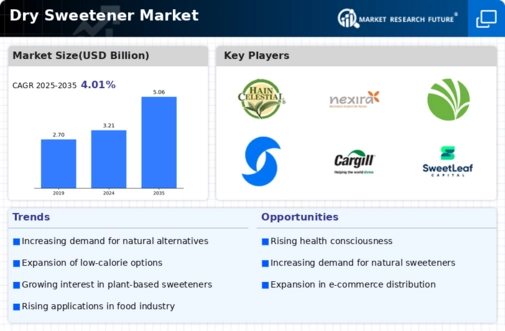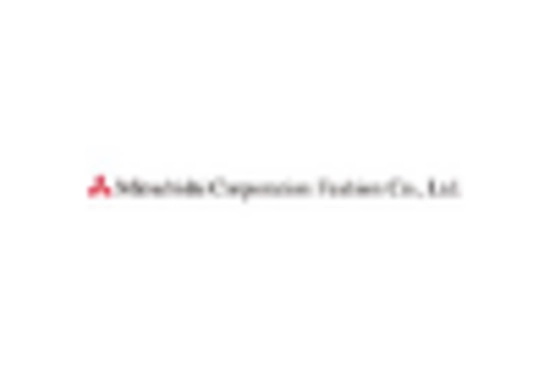Rising Health Consciousness
The increasing awareness of health and wellness among consumers appears to be a pivotal driver in the Dry Sweetener Market. As individuals become more informed about the adverse effects of excessive sugar consumption, there is a noticeable shift towards low-calorie and sugar-free alternatives. This trend is reflected in market data, which indicates that the demand for dry sweeteners, particularly those derived from natural sources, has surged. In 2023, the market for natural dry sweeteners was valued at approximately 1.5 billion USD, suggesting a robust growth trajectory. Consumers are actively seeking products that align with their health goals, thereby propelling the Dry Sweetener Market forward.
Innovations in Sweetener Technology
Technological advancements in the production of dry sweeteners are contributing to the evolution of the Dry Sweetener Market. Innovations such as improved extraction methods and enhanced processing techniques are enabling manufacturers to produce high-quality sweeteners with better taste profiles and functional properties. For example, the development of new enzymatic processes has led to the creation of dry sweeteners that are not only more efficient to produce but also offer superior sweetness levels. This technological progress is likely to attract both manufacturers and consumers, as it enhances the overall appeal of dry sweeteners. As a result, the Dry Sweetener Market is expected to witness increased investment in research and development, further driving market growth.
Expansion of Food and Beverage Sector
The ongoing expansion of the food and beverage sector is likely to bolster the Dry Sweetener Market significantly. As new products are introduced, manufacturers are increasingly incorporating dry sweeteners to cater to diverse consumer preferences. The sector's growth is evidenced by a projected increase in the number of new product launches, with an estimated 20% rise in the introduction of low-sugar and sugar-free options in 2025. This trend indicates that food and beverage companies are recognizing the importance of reformulating their products to meet consumer demand for healthier alternatives. Consequently, the Dry Sweetener Market is poised to benefit from this expansion, as more brands seek to enhance their offerings with dry sweeteners.
Regulatory Support for Healthier Products
Regulatory bodies are increasingly advocating for healthier food options, which appears to be a significant driver for the Dry Sweetener Market. Governments worldwide are implementing policies aimed at reducing sugar consumption, thereby encouraging manufacturers to explore alternative sweetening solutions. For instance, recent regulations in several regions have mandated clearer labeling of sugar content, prompting food producers to reformulate their products. This regulatory environment is likely to create a favorable landscape for dry sweeteners, as companies strive to comply with new standards. The Dry Sweetener Market may experience accelerated growth as a result of these supportive measures, which aim to promote public health and reduce the prevalence of diet-related diseases.
Consumer Preference for Clean Label Products
The growing consumer preference for clean label products is emerging as a crucial driver in the Dry Sweetener Market. Shoppers are increasingly scrutinizing ingredient lists and seeking products that contain recognizable and natural components. This trend is reflected in Market Research Future, which indicates that nearly 70% of consumers are willing to pay a premium for products labeled as clean or natural. As a response, manufacturers are reformulating their offerings to include dry sweeteners that meet these clean label criteria. This shift not only aligns with consumer expectations but also positions the Dry Sweetener Market favorably in a competitive landscape, as brands that prioritize transparency and quality are likely to gain a loyal customer base.


















Leave a Comment